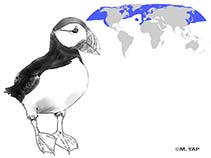Fratercula arctica (Linnaeus, 1758)
Atlantic puffin
Classification / Names Common names | Synonyms | CoL | ITIS | WoRMS
Aves | Charadriiformes | Alcidae
Environment: milieu / climate zone / depth range / distribution range Ecology
Others; depth range 0 - 60 m (Ref. 62202), usually 20 - 30 m (Ref. 62202). Polar; 83°N - 24°N, 85°W - 71°E (Ref. 124582)
Distribution Countries | FAO areas | Ecosystems | Occurrences | Introductions
Arctic, Northern Atlantic and the Mediterranean. Boreal to polar.
Length at first maturity / Size / Weight / Age
Maturity: Lm ? range ? - ? cm Max length : 30.0 cm TL male/unsexed; (Ref. 8812); max. published weight: 381.00 g (Ref. 356)
Short description Morphology
Culmen: 4.56 cm; tarsus: 2.88 cm; wing: 17.21 cm.
Total Length: 28 to 30 cm; Wingspan: 53 to 58 cm (Ref. 8812). Occupy the continental shelf; <100 km; exhibits plunge-diving feeding behavior (Ref. 356). In the North Sea off the east coast of Scotland and northern England, this species is known to feed on the sandeel, Ammodytes marinus and breeding birds spend approx. 80% of daylight period at sea, commonly in dense rafts. They form nesting colonies with breeding pairs sharing incubation and chick-rearing duties; surface-feeding by scooping prey from the water, they carry prey in their bills and feed their chicks with regurgitated food (Ref. 95711).
Life cycle and mating behavior Maturity | Reproduction | Spawning | Eggs | Fecundity | Larvae
Main reference
References | Coordinator | Collaborators
Barrett, R.T. and F. Rikardsen. 1992. (Ref. 4091)
IUCN Red List Status (Ref. 130435)
Vulnerable (VU) (A4abcde); Date assessed: 07 August 2018
CITES status (Ref. 108899)
Not Evaluated
CMS (Ref. 116361)
Not Evaluated
Threat to humans
Human uses
| FishSource |
Tools
More information
Internet sources
BHL | BOLD Systems | CISTI | DiscoverLife | FAO(Publication : search) | Fishipedia | GenBank (genome, nucleotide) | GloBI | Gomexsi | Google Books | Google Scholar | Google | PubMed | Tree of Life | Wikipedia (Go, Search) | Zoological Record
Estimates based on models
Preferred temperature
(Ref. 115969): 0.5 - 11.8, mean 6.8 (based on 976 cells).
Resilience
(Ref. 69278):
High, minimum population doubling time less than 15 months (K=8.27-39.05).
Price category
(Ref. 80766):
Unknown.



